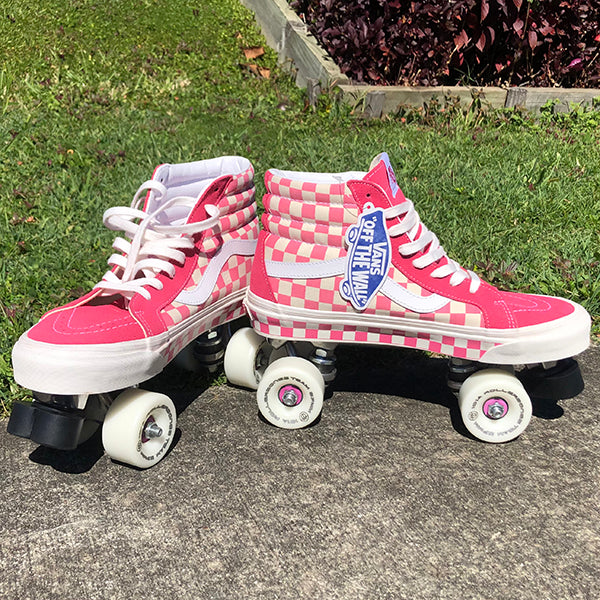Your Cart is Empty
US residents please shop through our distributor (click here) or our US stockists (click here)
Menu

US residents please shop through our distributor (click here) or our US stockists (click here)

Making your own custom skates
Sometimes as a skater you realise that the skates you find on the market just don’t reflect YOU quite well enough. When you find yourself in this grim situation, it’s time to consider a custom build! Better Bearings spoke with custom skate builder, Moldie (Jeremy) @M_Sk8 Ultra on how to go about making your own custom skates.
Here is what he had to say:
The options are vast, but the crucial things to consider are:
~What type of skating do you like to participate in?
~What type of shoe/boot do you want to mount to skate plates?
~What skate plates will you be using?
Answering these questions will guide you to some other critical conclusions in gathering what you need for your ideal personal skate build!
Most skates are pretty diverse and can be adjusted in minor ways to accommodate a range of skating styles, but some activities and accessories are better suited for more specific elements. I’ve found that most plates that come stock with entry-to-mid level skates are awesome all-purpose plates. Impalas, Chuffed, Moxi Panthers/Beach Bunnies all come with a very similar skate plate generally known as a “Stock Standard Marvel Plate”. They’re not super flashy, but they’re great all-rounders for everything from cruising to skateparks, and many accessories (like grind blocks) are made to fit these type of plates. Skaters with more specific needs or preferences can find a wide range of skate plates to suit their tastes that focus on specific traits like- weight, bushing adjustability, truck width, profile height, toe-stop adjustability and pivot angle to name a few.
The type of skating you want to do will have a hand in helping you decide what type of shoe or boot you’d like to use. Most skates on the market are sold with some heel height. Cruiser skates and artistic dance skates tend to have the most pronounced heel height while derby style skates are most often much lower. It’s important to remember, though, that while some people may find certain types of skates easier to do certain types of skating in, it really comes down to the individual. It often just takes time to adjust to going from heeled skates to flat skates or the other way around; practice makes perfect! Ankle support is often discussed, but many skaters have managed to strengthen their ankles to a degree that decreases their reliance on the support of a taller shoe or boot. There’s nothing wrong with a low-cut shoe for a skate, as long as it laces tight enough that your heel won’t slip out when you’re pushing along the footpath or through the skatepark. Platform shoes make funky awesome custom skates, but bear in mind that the added elevation changes the leverage your skates use to activate the trucks in turning, that is to say- your trucks may feel loose because they feel like they’re turning so much easier, and you may want to find stiffer bushings.
In most cases, an insole plate will need to be inserted inside the shoe in order to keep it securely attached to the skate plate. If not a full insole plate, some brackets may be used instead. These are important because most street shoes are not constructed in a way that is designed to manage the strain that skating puts on the shoe. When walking, the stress points on the shoe are largely just on the sole, where your foot lands when walking or running- normal use. In skating, a shoe takes on much stronger sideways forces as you push your foot off at an angle behind you to propel yourself forward. If your skate plate isn’t secured by being bolted to a plate inside the shoe, this force and the sheer weight of the skate plate and wheels could cause bolts to pull through the sole which could be catastrophic in the wrong situations. Another thing to consider is that whatever hardware is used inside the shoe to secure the plate bolts is bound to take up some space, and you may find that you need to up-size your shoe by ½ to a full size larger so the skates fit comfortably and don’t squeeze your foot. After all, if you’re putting all this effort into building custom skates, the last thing you want is for them to be unbearable to wear!
Of course once you have all these fundamentals hammered out, the rest is the fun stuff! Wheels, toe-stops, grind-blocks and, of course, BEARINGS are all the little pieces which fine-tune your skates to suit your needs. Better Bearings off these in a wide range of colours which can be coordinated in hundreds of amazing and creative ways, and all of them have their own unique functionalities as well. Wheel size and durometer (bouncines), toe stop size, shape and gumminess- there are options for all types of skating. My personal favourite bearings are anodized to help resist corrosion and have removable shields to make them easy to maintain and lubricate to keep them clean and FAST for whatever skating I find myself doing. Lickety Splits fit the bill perfectly!
Whatever skates you use, I’ll take important to remember~ have FUN in them. Skating is freedom, and it’s both very personal and very social. The more supportive you are of your local skate community and skate-related businesses, the stronger they’ll be and the longer they’ll last as a resource for YOU!
Moldie~ M Sk8 Ultra
Select a purchase option to pre order this product
Countdown header
Countdown message
Countdown message
DAYS
:
HRS
:
MINS
:
SECS